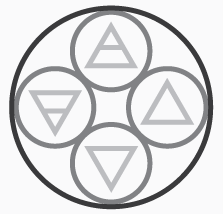
The Elemental Cycle
A Brief Introduction
Alchemy and the Four Elements
Heraclitus said, “You can never step into the same river twice,” by which he meant that transformation is a foundational principle of the cosmos. Although transformation can occur in a variety of ways, like any natural phenomenon, it is not a random process. Rather, lawful patterns can be discerned which describe how transformation occurs and give us a coherent experience of the unfolding of the cosmic dance. The alchemists have long understood this secret, and knew that if they could discover the order embedded within the natural world they would also find the key to their inner transformation, while reciprocally recognizing that their own spiritual progress could provide them with insights that could illuminate the mysteries of their environment. This principle is one of the oldest in alchemy, attributed to the legendary Egyptian Hermes Trismegistus and recorded on the Emerald Tablet: “That which is below is like that which is above, and that which is above is like that which is below” (Isaac Newton’s translation).
The alchemists used a number of methods to penetrate the “miracles of the One thing”, much of which is shrouded in either deliberate obscurity or unwitting confusion. This has led most modern thinkers to reject alchemy as some sort of mystical self-delusion and fantasy, used more to prey off of unsuspecting believers than to transform the world. Despite this, a modern-day alchemy does exist, and the wisdom of the Hermetic tradition is alive and well, and is – in accordance with its own wisdom – continuing to evolve.
Alchemy is the art of conscious transformation. The principle qualitative substances with which the alchemists work are the four elements: Earth, Water, Air, and Fire. These are understood as states through which any substance – whether in the form of outer mineral substance or of inner soul substance – must pass in order to evolve to a higher perfection. These four elements thus work together in a spiraling cycle as accurate metaphors for the process of transformation. By becoming familiar with the qualities and movements of the four elements, we can learn to sympathize our consciousness with the subtle patterns that describe lawful evolution. The elements thus form a mandala that can act as a guide from one stage to the next, whether we are working with an outer issue or an inner dilemma.
The elemental mandala is like a universal scaffolding for our consciousness: it provides a frame that allows for an endless number of possible habitations. We can learn how to recognize the elemental patterns in our lives, and to thus become co-creators in our own transformation and the transformation of the world. At the very least, the elemental mandala provides a useful tool through which we can better understand the mysteries of ourselves and our environment.

Like any esoteric tool, successful work with the elemental cycle correlates with the quality of our will and attention that we are able to bring to bear. Despite this, it is easy to begin, even if at first only conceptually. The elemental mandala itself will help you discover how to use the cycle – it will train you if only you provide it the fuel of your attention.
In working with the elemental mandala, I have come to believe that it can offer a practical avenue for self-transformation and exploration while also providing deep insights about the natural and spiritual worlds. This website is an attempt to share what I have learned about the elements, in the hope that it can be of benefit to you.
I am also interested in gaining feedback from anyone who is willing to put the elemental mandala to the test, in the spirit of further investigation and collaborative inquiry. To this extent I have devised a brief primer and a corresponding feedback form, which I invite you to use. What is your experience with the elements?
-peace-
-Seth Miller